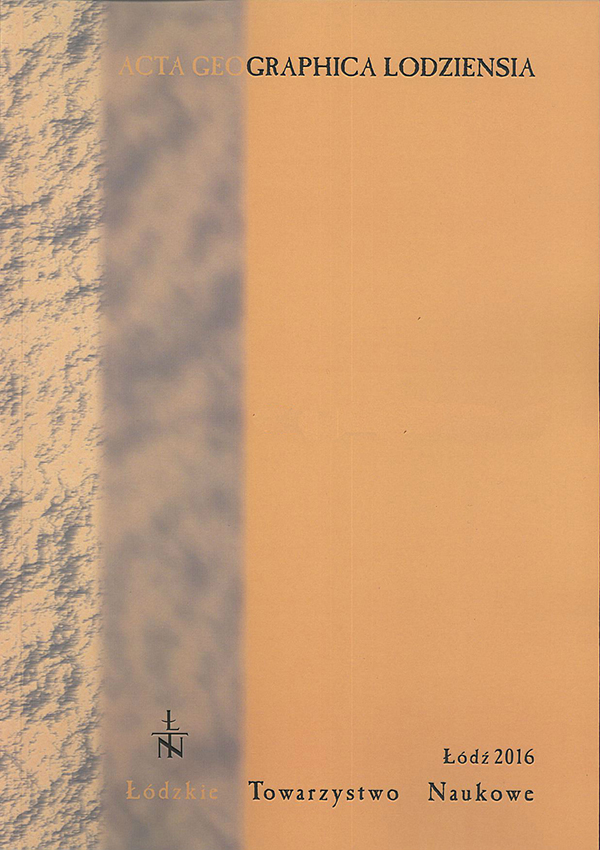Geneza jezior i torfowisk dorzecza Prypeci w świetle polskich badań okresu międzywojennego
The genesis of lakes and mires situated in the Prypeć River basin in light of the Polish research dating from the interwar era
Author(s): Sławomir ŻurekSubject(s): Geography, Regional studies, Environmental Geography
Published by: Łódzkie Towarzystwo Naukowe
Keywords: Polesie; peatland studies; origin and hydrology of peatland; lakes
Summary/Abstract: The biggest Polesie swamp basin in Europe, in the catchment area of the Pripyat River, was firstexamined as early as in the 19th century. (Rehman, Paczoski, Tanfiliew). In the interwar period, aspart of the framework of the Polish Government Bureau for Land Reclamation in Polesie, extensive research of the peatland was carried out by Professor S. Kulczyński and associates (Tołpa, Tymrakiewicz, Dąbkowska, Wilczek) of the University of Jan Kazimierz in Lvov. Throughout the period of five and a half years, 2833 drillings and 4357 floristic surveys were performed. They provided the basis for a map of the mires in Polesie (9048 km2 of fen peatlands, 2598 km2 of transition bog, and 868 km2 of raised bog ones) as well as a number of publications crowned with the two-volume composition by S. Kulczyński – “The Peat Bogs of Polesie” (“Torfowiska Polesia”) published in 1939/1940, followed by its English version in 1949. It discussed the vegetation, biology, hydrology,and the division of the peat bogs in Polsesie according to their natural types and genuses. The first work of S. Kulczyński appeared in 1930. It was the “Stratigraphy of the Peat Bogs of Polesie”, in which, based on 84 pollen analyses, he established the age of the bogs in relation to the land relief. The shallow alder-reed peat covers of the Pripyat and its tributaries are dated at the Early Holocene (since the Atlantic Period) while the sedge-moss peat covers of the watershed zones and the peat under gyttjas date back to the Late Glacial and Late Holocene. Kulczyński also stated that the Subboreal wasnot a dry period but a cool and humid one. The studies of Tołpa and Tymrakiewicz in the southern partof Polesie revealed evidence of karst processes in peatlands and lakes in the form of collapsing substratumand accumulation of gyttjas on moss peats. The most important achievement of the studies conducted in Polesie is the natural differentiationof the peat bogs on the basis of their hydrology. The peat bogs where through-flow of water is presentare always fen peatlands that occupy the bottoms of valleys or cover slopes. Peatlands connected withstill water with vertical fluctuations are raised bogs occupying watersheds and water logged areas. Thetransformation of a fen peatland into a transitional or a raised bog one is eventuated by the veering ofwater flow (e.g. stream capture). Continental raised bogs with flat surface grow as a result of peat accumulationin the peatlands of surrounding valleys. The banking up of groundwater in watersheds leads to the accumulation of in raised bogs. The hypothesis on the growth of peat cupolas through lenticular regeneration (alternating layers of bog ridges-hollows Sphagnum peat). The division withinfen peatlands into flooded (immersive) and sedge-moss supplied only by groundwater (emersive) remainsvalid to this day. The origin of the contemporary lakes was approached mainly as part of the geological studies.The Warsaw group led by Professor S. Lencewicz surveyed the lakes in the interfluve of the Bug andPripyat as well as in the Wołyń Polesie. A large majority of them is karst in origin.
Journal: Acta Geographica Lodziensia
- Issue Year: 2016
- Issue No: 105
- Page Range: 163-171
- Page Count: 9
- Language: Polish

